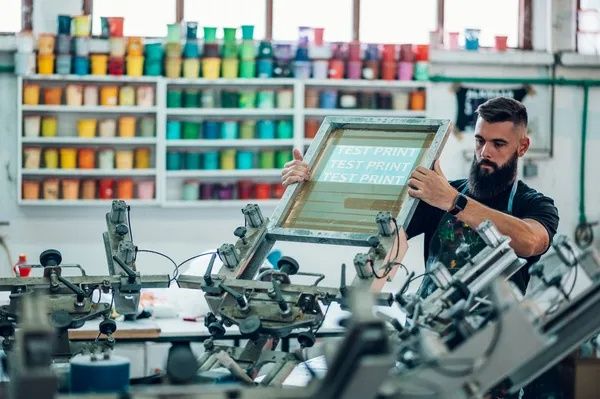Screen Printing Machines Explained: A Beginner’s Guide to Features and Functions
Screen printing machines are essential tools used to transfer ink onto various materials through a mesh screen. This process is most commonly used for creating custom prints on fabrics like t-shirts, but it also works for posters, ceramics, glass, wood, and metal. The technique has evolved over the decades, starting from manual screen printing to advanced automated systems that allow mass production and intricate designs.
At its core, the machine holds a screen tightly in place while ink is pushed through the mesh onto the printing surface using a squeegee. A stencil blocks off areas where ink should not pass, enabling the creation of detailed graphics and patterns.

Today, these machines are widely used in textile industries, promotional product manufacturing, art studios, and small businesses, offering creative flexibility and scalability.
Why Screen Printing Machines Matter Today
Screen printing remains one of the most reliable and cost-effective printing techniques, especially for large batch production. Its continued relevance is tied to several practical benefits:
-
Durability: Prints from screen printing are highly durable and resistant to wear and washing.
-
Vibrant colors: The ink layers are thicker compared to digital printing, producing rich and vivid colors.
-
Scalability: Ideal for printing hundreds or thousands of items with consistent quality.
-
Material flexibility: Can be used on cotton, polyester, glass, wood, plastic, and more.
Who benefits from it?
-
Small business owners offering personalized apparel or merchandise.
-
Independent artists producing limited-edition prints.
-
Corporate entities needing branded uniforms or promotional goods.
-
Educational institutions printing on team jerseys and event materials.
Screen printing helps bridge creativity and commerce, enabling high-quality, customized products at scale.
Recent Trends and Updates in Screen Printing
The screen printing industry has seen steady advancements in automation, eco-friendliness, and hybrid printing technologies. Key developments include:
-
Automated screen printing machines with programmable settings and robotic arms are gaining popularity, especially for high-volume production (Q4 2024).
-
Water-based and eco-friendly inks are being widely adopted to reduce the environmental footprint (as noted by Printwear Journal, March 2025).
-
Hybrid printing systems, which combine screen printing and digital methods, allow for more complex multicolor designs with reduced setup time.
-
AI-assisted design software is being integrated into pre-press workflows, simplifying design separation and screen setup.
These improvements are reducing manual labor and improving production efficiency, especially in countries like the U.S., Germany, and India where textile manufacturing is expanding.
Regulations and Policies Impacting Screen Printing
While there are no universal regulations specific to screen printing machines, related laws and environmental guidelines affect their operation. These include:
-
Occupational Safety Regulations – Operators must follow workplace safety standards (e.g., OSHA in the U.S., Factories Act in India) to avoid hazards such as chemical exposure or machinery accidents.
-
Environmental Guidelines – Disposal of used inks and cleaning solvents must comply with local waste management laws. Water-based and biodegradable inks are often encouraged or required.
-
Import/Export Duties – Tariffs and certifications may be needed when importing screen printing machines across borders (e.g., CE marking for the EU).
Governments also offer MSME support schemes and start-up grants that subsidize small-scale businesses investing in print production. These programs can help reduce costs for new entrants looking to purchase or upgrade equipment.
Helpful Tools and Resources for Screen Printing Beginners
Whether you’re starting a screen printing business or exploring it as a hobby, the following tools and resources can help you navigate the process:
Software & Design Tools:
-
Adobe Illustrator / CorelDRAW – For creating print-ready vector designs.
-
Separation Studio – Separates artwork into printable color layers.
-
InkSoft – A cloud-based design and order management platform.
Calculators:
-
Ink Usage Calculator – Estimates the amount of ink required per print batch.
-
Cost-per-print Calculator – Helps determine printing cost per unit.
Online Resources:
| Resource Type | Platform | Description |
|---|---|---|
| Community Forum | T-Shirt Forums | Beginner discussions, tips, equipment reviews |
| Learning Portal | Printavo University | Free courses on screen printing techniques |
| Video Tutorials | YouTube: Ryan Moor, Catspit Productions | Step-by-step guides on setup, printing, and maintenance |
-
4-color 1-station press
-
Flash dryer
-
Screen exposure unit
-
Squeegee and scoop coater
-
Screen emulsion and plastisol ink
For practice and small runs, tabletop and manual machines are affordable and effective. Larger businesses may opt for rotary or fully automatic screen printers.
Frequently Asked Questions (FAQs)
Q1: What’s the difference between manual and automatic screen printing machines?
Manual machines require human effort to operate and are suitable for small-scale jobs. Automatic machines handle most functions via motors and are ideal for high-volume production with consistent output.
Q2: Can I use screen printing on dark fabrics?
Yes. You’ll need to use a white or opaque base layer first, followed by color layers to ensure visibility and vibrancy on dark backgrounds.
Q3: Is screen printing more cost-effective than digital printing?
For large print runs, screen printing is more economical due to the low cost per unit. However, digital printing may be better for short runs or complex full-color images.
Q4: How long do screen-printed designs last?
With proper curing and quality inks, screen-printed designs can last for many years without fading or cracking.
Q5: What’s the environmental impact of screen printing?
Traditional screen printing can involve solvent-based inks and chemical waste. However, using water-based inks and biodegradable emulsions significantly reduces environmental harm.
Final Thoughts
Screen printing machines are powerful tools for both creative expression and commercial production. Whether you're printing t-shirts for a local event or starting a small apparel brand, understanding how these machines work and how to use them safely and efficiently—can help you get better results with lower costs and less waste.
By keeping up with industry trends, following regulations, and using the right tools and resources, beginners can confidently enter the world of screen printing and turn their ideas into lasting prints.
